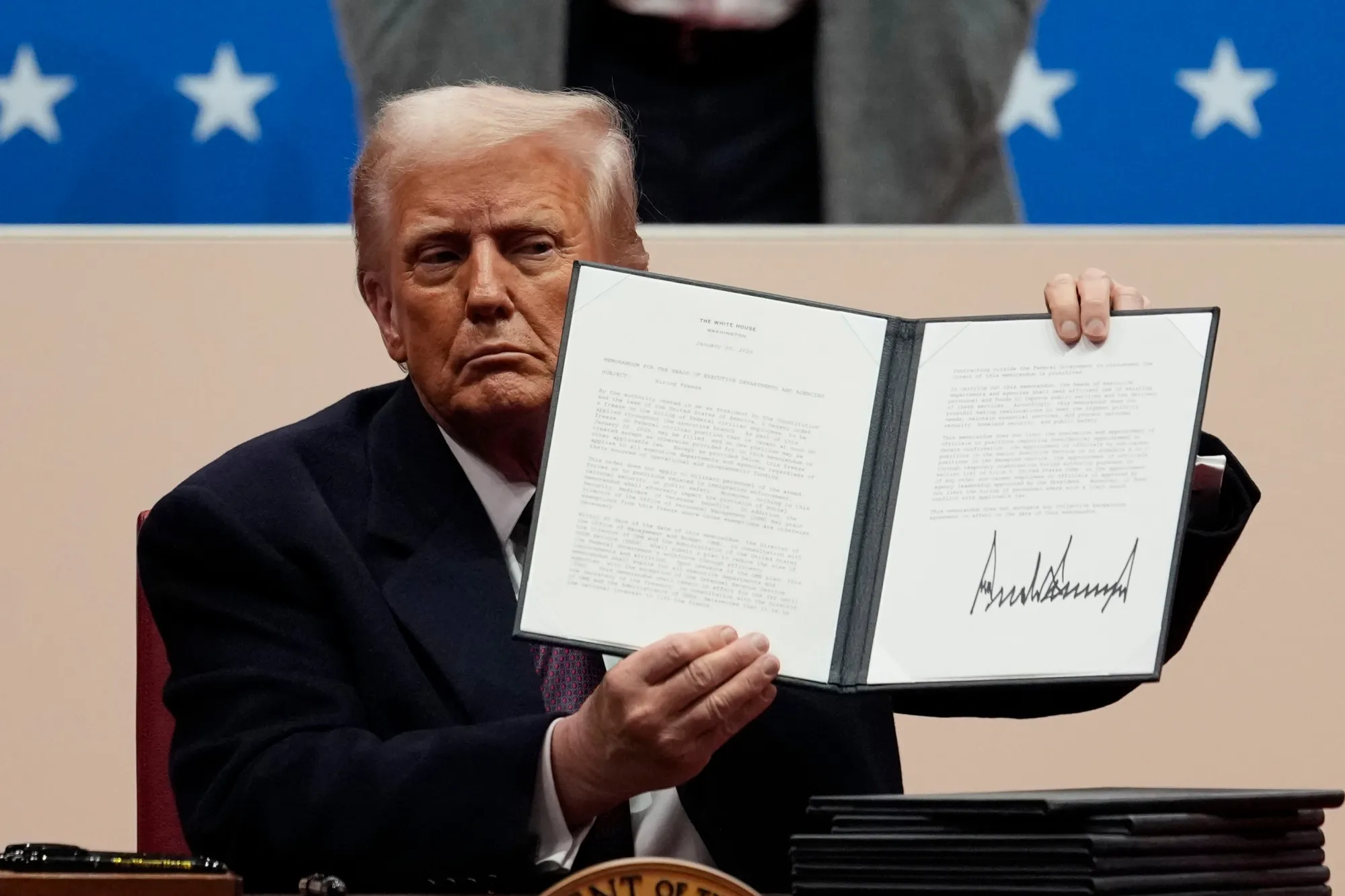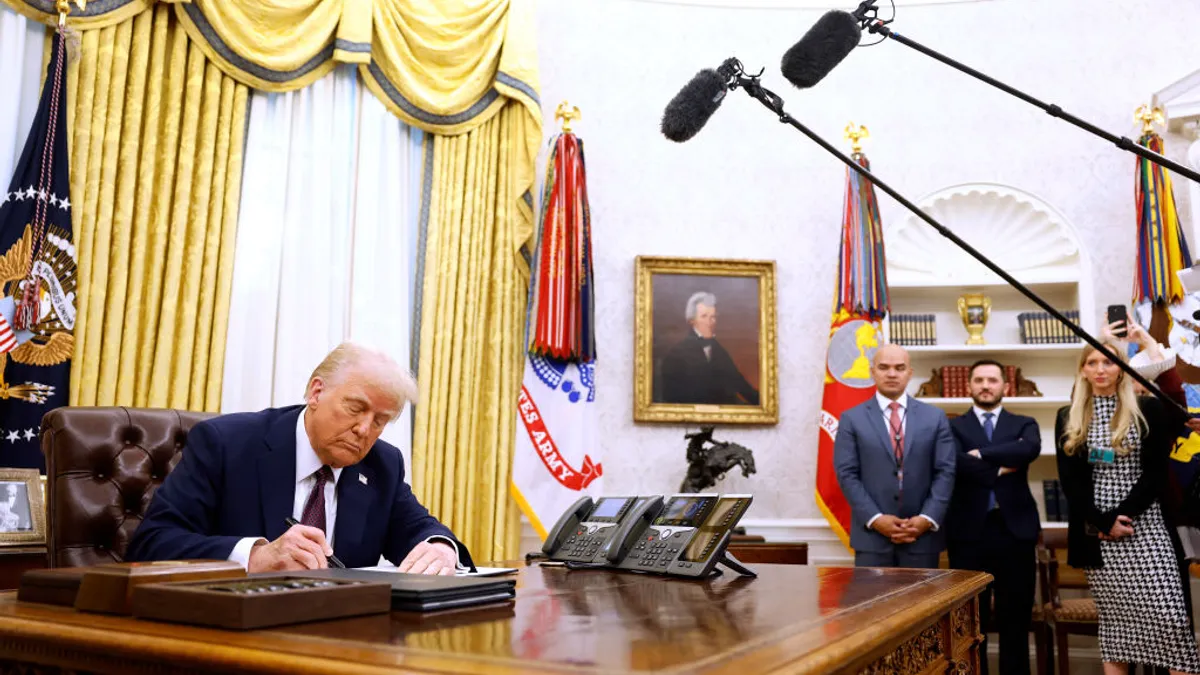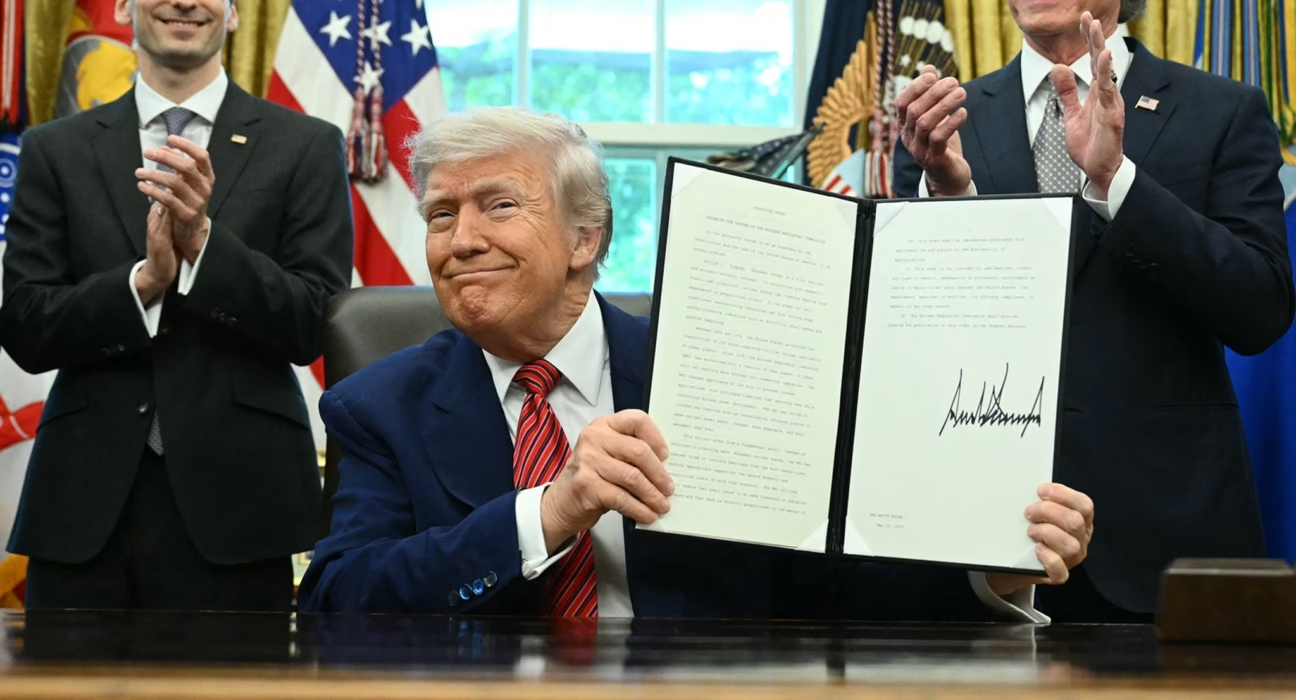Trump’s AI Executive Orders: Powering the Future of American Innovation
Estimated reading time: 7 minutes
Key Takeaways
- Donald Trump’s anticipated 2025 AI executive orders are designed to *remove regulatory barriers* and *support rapid innovation*, while simultaneously addressing the nation’s growing energy demands.
- The new framework prioritizes fostering an environment where U.S. AI innovation can flourish, centered on economic competitiveness, national security, and human flourishing, with a strong emphasis on *technological neutrality*.
- A coordinated national action plan, to be developed within six months, aims to solidify U.S. global leadership in AI by *ramping up research investment*, *supporting workforce development*, and *encouraging private-sector collaboration*.
- Boosting energy for AI expansion is critical, as modern AI models and data centers demand *vast computational power*, making a reliable and resilient energy supply foundational for continued AI development.
- The directives underscore the imperative to modernize U.S. power infrastructure, fostering public and private investment in *sustainable energy sources*, advanced energy storage, and smart grid solutions to support the future of AI power infrastructure.
- Energy security and infrastructure are central to the ongoing US-China AI race energy, with U.S. policy aiming to strengthen its strategic position and mitigate vulnerabilities through domestic investments.
- These executive orders are set to profoundly impact the U.S. economy, present sustainability challenges, and shape the trajectory of technological innovation, defining the next chapter in U.S. leadership.
Table of contents
- Trump’s AI Executive Orders: Powering the Future of American Innovation
- Key Takeaways
- I. Introduction: Unpacking Trump’s AI Executive Orders and Their Far-Reaching Implications
- II. The Core of Trump’s Proposed AI Directives: Fostering American Leadership
- III. Powering the Future: Boosting Energy for AI Expansion
- IV. Building Tomorrow’s Infrastructure: The Future of AI Power
- V. The Geopolitical Chessboard: US-China AI Race and Energy Dynamics
- VI. Anticipated Impacts and The Road Ahead
- Frequently Asked Questions (FAQ)
I. Introduction: Unpacking Trump’s AI Executive Orders and Their Far-Reaching Implications
The future of American innovation in artificial intelligence stands at a critical juncture. Donald Trump’s anticipated 2025 executive orders on artificial intelligence (AI) mark a pivotal moment in shaping the future of AI policy and infrastructure in the United States. These directives are not merely administrative adjustments; they are a strategic declaration designed to fundamentally reshape the nation’s approach to this transformative technology.

Central to their purpose, these trump ai executive orders are crafted to remove regulatory barriers and support rapid innovation. In doing so, they explicitly recognize the growing synergy—and inherent tension—between the relentless pace of accelerated AI expansion and the nation’s burgeoning energy demands. It’s a recognition that without robust, reliable, and abundant power, the promise of AI leadership remains elusive. The White House has stated:
“Donald Trump’s 2025 executive orders on artificial intelligence (AI) mark a pivotal moment in shaping the future of AI policy and infrastructure in the United States. Designed to remove regulatory barriers and support rapid innovation, these directives recognize the growing synergy—and tension—between accelerated AI expansion and the nation’s energy demands.”
– source: https://www.whitehouse.gov/presidential-actions/2025/01/removing-barriers-to-american-leadership-in-artificial-intelligence/
This blog post will delve deep into the specifics of these proposed orders, exploring their profound energy implications, the critical infrastructure needs they highlight, and the broader geopolitical context in which they are set. We will examine how these directives aim to foster a climate for groundbreaking AI advancements while ensuring the necessary power backbone is in place, thereby boosting energy for AI expansion and shaping the future of AI power infrastructure in the United States.
II. The Core of Trump’s Proposed AI Directives: Fostering American Leadership
At the very heart of the 2025 trump ai executive orders lies a clear objective: to propel the United States to undisputed global leadership in artificial intelligence. A key mechanism to achieve this, as outlined in the directives, is the *revocation of earlier AI policies*. These prior policies, sometimes perceived as overly cautious or bureaucratic, were viewed by the incoming administration as potential impediments to the swift progress deemed necessary for American dominance. The strategic aim is to sweep away any regulatory hurdles that could stifle innovation or slow down the pace of development.

The new framework itself is designed to emphasize and actively promote an environment where U.S. AI innovation can flourish. It stands firmly on three primary pillars, each critical to the nation’s long-term prosperity and security:
- Promoting economic competitiveness: Ensuring that American businesses and industries remain at the forefront of AI development and application, driving growth and creating new opportunities.
- Advancing national security: Utilizing AI as a strategic asset to enhance defense capabilities, cybersecurity (Breakthrough AI Cyber Defense Revolution), and intelligence operations, safeguarding the nation from emerging threats.
- Ensuring human flourishing: Directing AI development towards beneficial applications that improve quality of life, address societal challenges, and uphold ethical standards.
The administration has also signaled a profound commitment to “developing AI systems that are free from ideological bias.” This commitment to *technological neutrality* is a cornerstone of the new approach, aiming to foster market-driven progress rather than government-directed development. It underscores a belief that open competition and innovation, unburdened by specific ideological mandates, will yield the most robust and beneficial AI systems. The overarching sentiment is captured in research findings:
“Central to the 2025 executive orders is the revocation of earlier AI policies viewed as impediments to American progress. The new framework emphasizes fostering an environment where U.S. AI innovation can flourish, focusing on three primary pillars: promoting economic competitiveness, advancing national security, and ensuring human flourishing – source: https://www.whitehouse.gov/presidential-actions/2025/01/removing-barriers-to-american-leadership-in-artificial-intelligence/. The administration highlights the critical importance of “developing AI systems that are free from ideological bias,” signaling a commitment to technological neutrality and market-driven progress” – source: https://www.whitehouse.gov/presidential-actions/2025/01/removing-barriers-to-american-leadership-in-artificial-intelligence/.
In line with the broader trump administration ai strategy, these orders call for a coordinated national action plan. This ambitious plan is to be crafted within six months by an assembly of top science, technology, economic, and policy advisors. Its ultimate goal is clear: to solidify U.S. global leadership in AI, building upon previous efforts and accelerating new ones.
Key themes expected to be part of this comprehensive strategy include:
- Ramping up research investment: Significant federal funding and incentives for groundbreaking AI research across universities, national labs, and the private sector.
- Supporting workforce development in AI-related fields: Programs aimed at training and retraining the American workforce for high-demand roles such as data scientists, AI engineers, ethicists, and other specialized AI professionals. This includes initiatives like the ones designed to advance AI education for American youth.
- Encouraging private-sector collaboration: Fostering public-private partnerships, streamlining regulatory processes, and providing incentives to encourage companies to invest in U.S.-based AI research, development, and deployment. This includes efforts to spur collaboration in AI education.

These pillars reflect a holistic approach, recognizing that leadership in AI requires not just technological prowess but also a robust ecosystem of talent, infrastructure, and strategic partnerships. As highlighted:
“In line with the broader Trump administration AI strategy, these orders call for a coordinated national action plan within six months, crafted by top science, technology, economic, and policy advisors, to solidify U.S. global leadership in AI – source: https://www.whitehouse.gov/presidential-actions/2025/01/removing-barriers-to-american-leadership-in-artificial-intelligence/ – source: https://trumpwhitehouse.archives.gov/ai/. Key themes include ramping up research investment, supporting workforce development in AI-related fields, and encouraging private-sector collaboration” – source: https://www.whitehouse.gov/fact-sheets/2025/04/fact-sheet-president-donald-j-trump-advances-ai-education-for-american-youth/ – source: https://trumpwhitehouse.archives.gov/ai/.
III. Powering the Future: Boosting Energy for AI Expansion
The relentless march of artificial intelligence is undeniably linked to an equally relentless demand for energy. As advanced AI models and data centers proliferate across the nation, so do their staggering energy requirements. Consider this: modern AI training and deployment—especially for cutting-edge applications like large language models (LLMs) and real-time AI applications—demand *vast computational power*. This translates directly into an escalating need for significant electricity consumption, often operating around the clock. The sheer scale is immense, with some AI training runs consuming as much energy as small towns.

Meeting these escalating energy demands is no longer merely a logistical challenge; it is increasingly seen as crucial to sustaining America’s AI edge. Without a robust and reliable power supply, the ability to innovate, train larger models, and deploy complex AI solutions at scale could be severely hampered, ceding ground to global competitors. Research supports this critical link:
“As advanced AI models and data centers proliferate, so do their energy requirements. Modern AI training and deployment—especially large language models and real-time applications—demand vast computational power, translating to significant electricity consumption. Meeting these demands is increasingly seen as crucial to sustaining America’s AI edge” – source: https://www.whitehouse.gov/presidential-actions/2025/01/removing-barriers-to-american-leadership-in-artificial-intelligence/.
The trump ai executive orders explicitly touch upon the necessity of boosting energy for AI expansion. While the precise policy mechanisms will emerge with the forthcoming national action plan, the orders are expected to promote incentives for energy infrastructure growth and innovation. This could manifest in various forms: accelerated permitting for new power generation facilities, tax credits for energy-efficient data centers, or direct investments in grid modernization.
It’s clear that the administration recognizes a fundamental truth: an abundant, reliable, and resilient energy supply is not just *helpful* for continued AI development; it is *foundational*. Without it, the ambitious goals of U.S. AI leadership cannot be fully realized. The orders acknowledge this implicitly, laying the groundwork for policies that will prioritize securing the energy resources necessary to fuel the next generation of AI breakthroughs.
“The Trump executive orders touch on the necessity of “boosting energy for AI expansion,” likely through incentives for energy infrastructure growth and innovation. While specific policy mechanisms are pending the forthcoming national action plan, the orders acknowledge that an abundant, reliable, and resilient energy supply is foundational for continued AI development” – source: https://www.whitehouse.gov/presidential-actions/2025/01/removing-barriers-to-american-leadership-in-artificial-intelligence/.
IV. Building Tomorrow’s Infrastructure: The Future of AI Power
Addressing the energy-intensive nature of AI, the executive orders bring into sharp focus the significant challenges inherent in modernizing and scaling the U.S. power infrastructure. This isn’t merely about adding more megawatts; it’s about fundamentally transforming how the nation generates, transmits, and distributes electricity to support an economy increasingly reliant on computational power. The scope of this modernization is vast, encompassing several critical areas:

- Expanding the grid: Increasing the capacity and reach of existing transmission lines and substations to accommodate new energy demands from AI data centers and other high-load facilities.
- Integrating sustainable energy sources: Actively incorporating a wider array of renewable energy sources such as solar, wind, and geothermal into the national energy mix, recognizing their potential to provide clean and increasingly cost-effective power for AI operations.
- Enhancing distribution efficiency: Implementing advanced technologies and practices to minimize energy loss during transmission and distribution, ensuring that power reaches its destination with maximum efficiency.
As the research indicates:
“Addressing the energy-intensive nature of AI, the executive orders highlight challenges in modernizing and scaling U.S. power infrastructure. This includes not only expanding the grid but also integrating sustainable energy sources and enhancing distribution efficiency to support both urban data centers and emerging tech hubs” – source: https://www.whitehouse.gov/presidential-actions/2025/01/removing-barriers-to-american-leadership-in-artificial-intelligence/.
The anticipated policy environment is designed to foster both public and private investment in energy technology. This strategic push could spur groundbreaking advancements in several vital areas, shaping the future of AI power infrastructure:
- Renewable generation technologies: Further innovation in solar panel efficiency, wind turbine design, and other clean energy solutions to meet the growing demand for sustainable power.
- Advanced energy storage solutions: Development and deployment of next-generation batteries (e.g., solid-state, flow batteries) and other storage methods like pumped hydro, crucial for ensuring consistent power supply when renewable sources are intermittent.
- Smart grid solutions: Implementation of intelligent systems that optimize energy flow, enable real-time demand-side management, and enhance grid resilience. This also ties into the development of game-changing 5G-powered smart cities, where interconnected systems rely on efficient energy distribution.

Such modernization efforts are positioned as absolutely *imperative* for maintaining AI momentum. The administration understands that without a forward-looking and adaptable energy infrastructure, the ambitious goals for AI innovation cannot be responsibly met, particularly when considering environmental impacts. This strategic investment in boosting energy for AI expansion is seen as a dual benefit: fueling technological progress while concurrently working towards a more sustainable energy future. The emphasis on sustainability and efficiency aligns with global trends and reinforces the U.S.’s commitment to responsible technological advancement.
“The anticipated policy environment aims to foster public and private investment in energy technology, potentially spurring advancements in renewable generation, energy storage, and smart grid solutions. Such modernization efforts are positioned as imperative for maintaining AI momentum while managing environmental impacts” – source: https://www.whitehouse.gov/presidential-actions/2025/01/removing-barriers-to-american-leadership-in-artificial-intelligence/.
V. The Geopolitical Chessboard: US-China AI Race and Energy Dynamics
The global AI landscape is increasingly viewed through the lens of a geopolitical competition, most notably between the United States and China. In this intensifying AI rivalry between the U.S. and China, energy security and infrastructure are no longer peripheral concerns; they now play truly *critical roles*. The capacity to power vast data centers, train colossal AI models, and support widespread AI deployment directly impacts a nation’s strategic capabilities and economic competitiveness.

The trump ai executive orders explicitly frame AI dominance as essential for both economic prosperity and national security. This perspective implicitly recognizes that access to robust, reliable, and *affordable* energy resources fundamentally underpins leadership in AI research, deployment, and commercialization. A nation with an unstable or insufficient energy supply cannot realistically hope to lead in the AI revolution, regardless of its intellectual capital. As noted:
“Energy security and infrastructure now play critical roles in the ongoing AI rivalry between the U.S. and China. Trump’s executive orders frame AI dominance as essential for economic and national security, implicitly recognizing that access to robust energy resources underlies leadership in AI research, deployment, and commercialization” – source: https://www.whitehouse.gov/presidential-actions/2025/01/removing-barriers-to-american-leadership-in-artificial-intelligence/.
By prioritizing energy independence and supply chain security in the context of AI, the U.S. aims to shore up its strategic position against rising global competitors. This involves not only domestic energy production but also ensuring that the components and expertise required for energy infrastructure—and indeed for AI hardware itself—are secure from external vulnerabilities.
Strategic investments and policy incentives targeting domestic energy and AI supply chains could significantly help the U.S. mitigate vulnerabilities. This reinforces its standing in the intensifying us china ai race energy, ensuring that the foundational elements for AI leadership are not subject to geopolitical leverage or disruptions. The directives signal a comprehensive approach where energy policy and AI strategy are inextricably linked, forming a unified front in the competition for global technological preeminence.
VI. Anticipated Impacts and The Road Ahead
The trump ai executive orders are poised to unleash a cascade of far-reaching impacts across various facets of American society and economy. Understanding these potential shifts is crucial for stakeholders across industries.
-
Economic Impact:
Accelerated AI adoption, spurred by reduced regulatory burdens and strategic investments, could significantly boost productivity across diverse sectors—from manufacturing and healthcare to finance and agriculture. This wave of innovation is expected to create entirely new industries, such as specialized AI services, advanced robotics, and bespoke AI hardware development. Crucially, it could also spur high-skilled job growth, provided the necessary energy and policy foundations are firmly in place, and the workforce is adequately trained. The economic benefits are projected to be substantial:
“Accelerated AI adoption could boost productivity, create new industries, and spur high-skilled job growth, provided the necessary energy and policy foundations are in place” – source: https://www.whitehouse.gov/presidential-actions/2025/01/removing-barriers-to-american-leadership-in-artificial-intelligence/ – source: https://www.whitehouse.gov/fact-sheets/2025/04/fact-sheet-president-donald-j-trump-advances-ai-education-for-american-youth/ – source: https://trumpwhitehouse.archives.gov/ai/.
-
Environmental Impact:
While AI offers immense potential, its increasing energy demand poses significant sustainability challenges. The proliferation of powerful data centers and intensive AI model training operations will undoubtedly increase electricity consumption. Therefore, the directives’ emphasis on boosting energy for AI expansion must be accompanied by robust investments in clean energy sources and efficiency measures. These efforts will be critically important to mitigate the environmental footprint of burgeoning AI infrastructure and ensure that technological progress aligns with ecological responsibility.
-
Technological Impact:
By establishing clear national policies and committing to crucial infrastructure upgrades, the U.S. is positioning itself to maintain its innovation lead. This coordinated approach will enable the nation to responsibly scale AI capabilities, fostering a robust and dynamic domestic AI ecosystem. This proactive stance ensures that American researchers and developers have the resources and supportive environment needed to push the boundaries of AI technology.
“Coordinated national policies and infrastructure upgrades could enable the U.S. to maintain its innovation lead while responsibly scaling AI capabilities” – source: https://www.whitehouse.gov/presidential-actions/2025/01/removing-barriers-to-american-leadership-in-artificial-intelligence/.

The outlook for these directives is one of transformative potential. As the national AI action plan is developed and implemented, these directives are poised to shape not only the trajectory of AI development but also the evolution of America’s energy and technology landscape. The critical intersection of executive policy, cutting-edge AI innovation, and resilient energy infrastructure will undoubtedly define the next chapter in the U.S. technological leadership story. This proactive stance in cultivating the future of AI power infrastructure is a testament to the nation’s commitment to remaining at the forefront of global innovation.
“As the national AI action plan is developed and implemented, these directives are poised to shape not only the trajectory of AI development but also the evolution of America’s energy and technology landscape. The intersection of executive policy, AI innovation, and energy infrastructure will define the next chapter in the U.S. technological leadership story” – source: https://www.whitehouse.gov/presidential-actions/2025/01/removing-barriers-to-american-leadership-in-artificial-intelligence/ – source: https://trumpwhitehouse.archives.gov/ai/.
Frequently Asked Questions (FAQ)
-
Q1: What are the primary goals of Trump’s anticipated AI executive orders?
A1: The primary goals are to remove regulatory barriers, support rapid innovation in AI, foster U.S. global leadership, and ensure the necessary energy infrastructure is in place to support this expansion, focusing on economic competitiveness, national security, and human flourishing.
-
Q2: How do these orders address the energy demands of AI?
A2: The orders acknowledge that an abundant, reliable, and resilient energy supply is foundational for continued AI development. They are expected to include incentives for energy infrastructure growth, modernization, and the integration of sustainable energy sources to meet the vast power needs of AI data centers.
-
Q3: What is the significance of “technological neutrality” in the new AI framework?
A3: Technological neutrality signifies a commitment to developing AI systems free from ideological bias, promoting market-driven progress rather than government-directed development. This approach aims to foster open competition and innovation in the AI sector.
-
Q4: How do these orders relate to the U.S.-China AI rivalry?
A4: The orders frame AI dominance as essential for economic and national security, implicitly recognizing that robust energy resources underpin leadership in AI. By prioritizing energy independence and supply chain security, the U.S. aims to strengthen its strategic position and mitigate vulnerabilities in the ongoing geopolitical competition with China in AI.
-
Q5: What are the anticipated environmental impacts of accelerated AI expansion?
A5: Increased energy demand for AI poses sustainability challenges. The executive orders’ focus on boosting energy for AI expansion necessitates significant investments in clean energy sources and efficiency measures to mitigate the environmental footprint of growing AI infrastructure.






